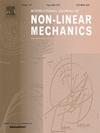Effective response and microstructure evolution for shape memory alloy laminated composites
Abstract
A model for the macroscopic mechanical behavior of rank-1 laminates including two shape memory alloy (SMA) phases is presented. The model expresses the general behavior of the composite with phases undergoing rate-independent elastic and inelastic deformations. Homogenization techniques (including the rank-1 laminate model) are used to establish the effective behavior of the SMA laminated composite (SLC) based on the information about the mechanical response of the individual phases and their volume concentrations. A stress-control algorithm is put forward to implement the model. With the aid of the stress-control algorithm, an implicit expression for the effective tangent stiffness and an evolution equation for the effective inelastic strain are derived. Results are compared with the outcomes of an FE-based computational homogenization and a very good agreement is seen. By using a constitutive model with internal variables for the dense SMA, the overall response of the SLC under different mechanical loadings is evaluated. The effective response of the SLC for various volume concentrations of the phases is assessed and exclusive comparisons are illustrated. Furthermore, the influence of different temperatures on the effective superelastic behavior of the SLCs is studied. The findings have implications for the analysis and the design of more complex shape-memory-alloy laminated composites for high-end applications.

 求助内容:
求助内容: 应助结果提醒方式:
应助结果提醒方式:


